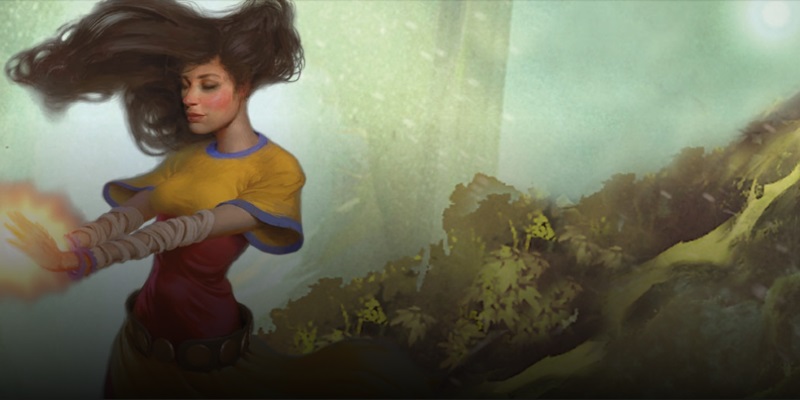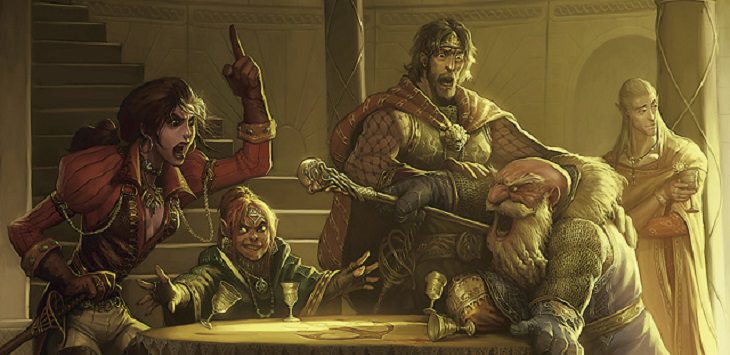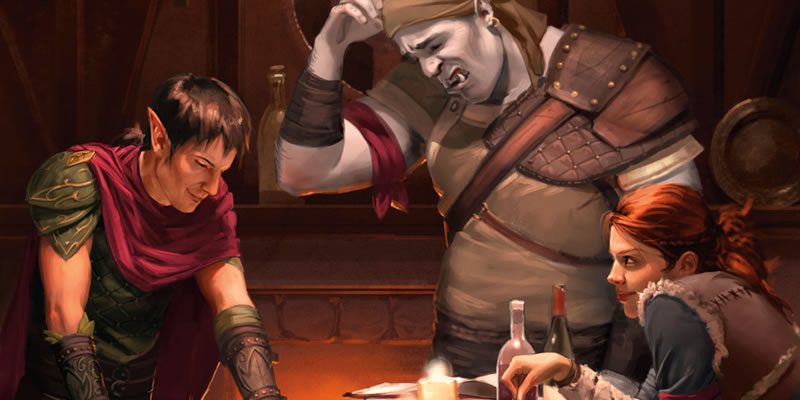Unearthed Arcana: Monastic Traditions Breakdown

This week’s Unearthed Arcana is another of the less-represented classes, in terms of quantity of archetypes: the monk. Admittedly, the Way of the Four Elements monk has a lot of internal customization, so it could be a ton of different things. The new Monastic Traditions are the Way of the Kensei and the Way of Tranquility, which are about as opposite in concept as they could be. As part of this, I want to talk about the challenges of playing a pacifistic character in a D&D-based tabletop game, and how to do that without gatekeeping everyone else’s fun.
Way of the Kensei
Thematically, the Kensei is the monk’s answer to the Battle Master – a warrior-artist, but in this case without spending any features on the “artist” side. To be fair, though, monastic traditions pretty consistently steer clear of ribbon features. I’m not sure why that is. Let’s get to it.
- Path of the Kensei grants a series of features, much like core monk’s Martial Arts feature. It’s necessary, because it’s stacking on top of Martial Arts to open the way to using things that aren’t usually monk weapons.
- Proficiency in three martial weapons. This tags them as “kensei weapons” for you, which matters in other features. Thus they support sword saints as well as Kyūdō, even within the same character.
- You can use Strength or Dexterity as your attack stat for any of these three weapons, and you can use your Martial Arts die with them. This is important because high Strength/low Dex is not a great approach for monks. The problems in the Strength/Dex metagame, however, are not helped here.
- When you use the Attack action, you can spend a bonus action to add 1d4 do your weapon damage for the turn. This raises the question of when 0d4, 1d4, or 2d4 extra damage are a good trade for one or (with ki expenditure) two extra attacks, each of which can do 1dX + stat modifier. The answer is, “when using a ranged weapon,” which is awkward because the text describes the extra damage as coming from pummeling the target.
- Well, nuts, now I get it. Kensei weapons aren’t monk weapons, so Martial Arts doesn’t apply, but Flurry of Blows does. So this is for when you don’t feel like spending ki. It also means the kensei is struggling to be damage-output-neutral compared to a monk that has no subclass. Kensei have better damage dice at low levels, but I’m not sure it’s enough better to carry a subclass.
- If one of your attacks in a round is unarmed, you can use the kensei weapon in hand for defense, gaining +2 AC. The value proposition here depends heavily on your level and your favored martial weapon, as that indicates how much damage output you’re missing by going for an unarmed strike in place of a weapon strike. Flurry of Blows isn’t part of your Attack action, so your unarmed strikes from it don’t satisfy this conditional.
- One with the Blade makes your weapon an extension of your ki. I bet it also makes your weapon make certain awesome noises, but I don’t blame them for leaving that out of the rules text.
- Ki-Empowered Strikes applies to your weapon. I get that they don’t want to assume the presence of magic weapons, but I’m betting 95% of kensei monks have a +1 weapon or better by 6th Just a guess.
- Precise Strike expends your bonus action to double your proficiency bonus for a single attack. The only situation I can see where this is really a sensible approach, rather than just making more attacks, is when you’re using the Great Weapon Master or Sharpshooter feats and you need a counter to your -5 to hit. You can use this only once per short or long rest, which seems real stingy when it also costs a precious bonus action.
- Sharpen the Blade lets you convert ki into attack and damage bonus on your weapon at 1:1, to a limit of 3, for 1 minute. It looks like this stacks with any existing attack and damage bonus on the weapon. This also costs a bonus action… because the monk didn’t have enough things competing for their bonus action every round?
- Unerring Accuracy allows you to reroll one missed attack roll on each of your turns.
Without seeing this in action at the table over the course of many levels, it’s hard to be sure of how often its more situational features will come up. The archetype looks substantially underpowered to me; its primary effect before 11th level is making some feats that monks normally ignore more appealing (Great Weapon Master, for starters). What I get from the mechanics is “I express ki through a nontraditional weapon,” not “sword saint.” I’m not sure what would meet my idea of sword saint, though, since my only contact with the idea in fiction is the Nyeung Bao of the Black Company series. It’s vague as hell, but I’d like to see the mechanics express more nuance in theme. The decision-making and tradeoffs in Path of the Kensei, compared to Martial Arts, don’t feel great to me.
EDITED TO ADD: There’s a ton of conversation online about whether the Kensei’s ability to use other weapons is overpowered, and around parsing Path of the Kensei vs. Martial Arts. Let’s break this down at various level bands, with a few base assumptions: Alice is a monk with 20 Str, a greatsword, and a longbow; Bob is a monk with 20 Dex and a greatsword.
At 3rd level, Alice makes one attack with her greatsword (2d6 + 5), and for 1 ki can add a Flurry of Blows (1d4 + 5, 1d4 + 5). This differs from a baseline monk by an average of 2.5 damage (quarterstaff avg 4.5, greatsword avg 7), which is a fairly big deal at 3rd level. In rounds where she doesn’t spend ki, which is a good bit of the time at this level, she chooses between (2d6 + 1d4 + 5) or (1d8 + 5, 1d4 + 5), which favors the staff by 2.5 damage. With a longbow, she makes one attack at 1d8 + 1d4 + 5, assuming the DM shrugs off the melee-only implications of “pummel.”
If Alice gets heavy armor proficiency from some other source, she can ditch Wisdom as a stat and just wear heavy armor. The AC comparison in the long haul comes down to how powerful of magic armor she acquires, but she can probably put a better score in Con as a result, so there’s some net gain here. Also Stealth disadvantage. Also, because she’s going for big weapon damage with the greatsword, she functionally loses Deflect Missiles.
At 3rd level, Bob’s attack routine matches Alice’s. Heavy armor holds no attraction for him, of course, since he doesn’t want to spend a good ability score on Strength just to avoid a speed hit from heavy armor.
At 5th level, Alice gets Extra Attack. This is where things start to get complicated. She can:
- attack twice with her greatsword (we’ll call it 4d6 + 10 for simplicity) and twice unarmed (2d6 + 10) for 1 ki,
- or twice with her greatsword and pummeling (4d6 + 2d4 + 10) for no ki,
- or she can attack once with her greatsword and once unarmed, then again unarmed as a bonus action (because she now satisfies a technical read of Martial Arts), for (2d6 + 5, 1d6 + 5, 1d6 + 5) for no ki, gaining +2 AC. Compared to the second option above, it’s exactly the same (because the average of 2d4 is 5).
- She needs to be careful with her bonus action economy, because she doesn’t want to miss out on a free greatsword attack from Great Weapon Master – so she’s hoping like crazy to crit or reduce something to 0 hit points during her action.
This is all basically the same for Bob, except that Bob invests in Wisdom as his secondary stat rather than Con, so his Stunning Strikes are good rather than… not. He sometimes has a better AC, but always has fewer hit points. He acts a lot sooner in combat than she does, but that really only matters in the opening round.
As they gain levels, their unarmed damage scales up, ending in Flurry of Blows rounds that are (4d6 + 2d12 + 20), and non-FoB rounds that have the decision tree I described above. Pummeling mostly stops being a good idea at 11th level, once two unarmed attacks are decisively better than one greatsword attack. The right to spend ki to improve the greatsword is solid, but compared to the damage increases that other classes get at or near that level, +3 attack and damage for two attacks per round (or three if you trigger Great Weapon Master) is far from game-breaking.
Things do get a lot weirder if haste is active, and I’m not going to break that down here. I’m also not covering shield-using kensei or multiclassed fighter/monks (though that’s one of the clearest ways to get to heavy armor proficiency).
Please let me know if you spot errors in my math or decision trees.
Way of Tranquility
The Way of Tranquility monk – I guess we’ll call them Tranquil monks, to strip it down to a single-word adjective? – sets out to make a playable pacifist. Pacifism is a hard road in any kind of heroic adventure, all the more so if you’re sharing the spotlight with people who don’t have magical pacifism powers. I’m going to come back around to the point of how to play a pacifist constructively, so that everyone in the group has more fun, but first let’s just tackle this subclass.
NB: The flavor text calls out that they aren’t strict pacifists and will end you if all other reasonable efforts fail.
- Path of Tranquility is, amusingly to me, very much like the Open Hand monk’s Tranquility feature, but can be renewed more often – so getting pushed into fighting once doesn’t break your sanctuary for the whole day, just for a minute. Also, once a creature passes a save against your sanctuary, it can beat you up all day long.
- Healing Hands is a Wholeness of Body that isn’t self-only and grants 10 points of healing per monk level rather than 3. Much like paladins, you can also purge diseases and poisons for 5 points of healing per affliction. This positions the monk to be a phenomenal secondary healer, or a stretched-somewhat-thin primary healer. Also, you can use Healing Hands in place of one attack during a Flurry of Blows.
- I like seeing as many classes as possible have some way to be a strong healer, because the people who want to play support shouldn’t have to play the same class and subclass every time. Big fan of this bit.
- The heal-during-Flurry rule is interesting, and I take it as a nod to how healing word still lets the healer do other stuff with their turn.
- It’s super weird that the two features at 3rd level are straight upgrades of Way of the Open hand features.
- Emissary of the Prophets Peace is a monk feature that focuses on social encounters. Will wonders never cease? You gain advantage on (sincerely-made) Charisma checks to avoid violence, and proficiency in either Performance or Persuasion.
- Waiting until 6th level to pick up Persuasion proficiency, if you didn’t get it from a Background, is rough for this monastic order concept. This should probably get swapped with Path of Tranquility. (Healing Hands is core playstyle stuff, and I would not like to see that pushed any later than 3rd.)
- Douse the Flames of War lets the monk impose peace on a target for up to 1 minute, if it fails a saving throw. Oh, and it automatically succeeds its saving throw if its current hit points are less than its maximum hit points. Interestingly, there’s no cost attached – no ki, no per-short-rest – other than the action and the need to be in touch range. This is the monk’s best shot at turning a fight into a conversation, as long as the rest of the team is on board. If they’re not, well, the person who wants to fight always gets their way.
- EDIT: I originally said it automatically failed its saving throw if it was missing any hit points, which is exactly wrong. I knew what the right wording was, I just wrote the wrong word because it was super late.
- Anger of a Gentle Soul is the subclass’s last feature and last resort. If you’re avenging someone you have just seen taken down or killed, it is on like an ape throwing giant fucking barrels at Italian-American plumbers and you add your monk level to damage until the end of your next turn. This costs your reaction and refreshes on a short rest.
- It’s a shame that this is delayed until 17th level, but you’re going to end someone when it happens, so that’s satisfying.
So… this is tough. These guys are, in a technical sense, probably overpowered. But to get the advantage of their overpowered-ness, they have to play the weak hand of never being the first to strike and delaying or averting combat. Only when someone else has really taken it on the chin do they break bad and end somebody. Right around the turn of the millennium, everyone figured out at roughly the same time that roleplaying restrictions were not a viable balance for superior punchy-fighty. In some ways, this subclass finds a loophole in that lesson, because its mechanics enforce the roleplaying restrictions.
On the other hand, it’s damn close to just being a rework of the Open Hand. I would probably make Tranquility and Open Hand the same Order, and every monk who rises through the ranks favors one set of lessons or the other.
Let’s Talk About Pacifism
I have great respect for committed, ethical pacifists in the real world, just so I’ve said that. It’s a tough row to hoe in a heroic-adventure gaming environment, though, and I want to discuss both the pitfalls and the ways I’ve seen it work well.
If you play a pacifist and establish your character goal as stop all fights before they start, and the rest of the party isn’t 110% on board with doing the same, you’re setting things up so that either you get what you want, or the rest of the group gets what they want. Get used to disappointment. This is the most-incorrect approach.
If you play a pacifist and talk it out with the rest of the team at the start of play, that’s a better approach. Even with prior discussion, though, it gets pretty tedious if your character takes every violent act as a personal failure, or reprimands the rest of the characters for engaging with the content.
The still better approach is to emphasize investigation, buffs, and healing during combat, supporting the team without personally engaging in violence. Investigation is particularly good because you may be advancing the party’s secondary goals, or spotting new secondary goals that would have otherwise gone unnoticed. This doesn’t mean “wander off and piss off more monsters” – that’s making things worse and making the rest of the party seriously question why they brought you along. Instead, you’re gathering details about the enemy or the terrain that you or an ally can exploit creatively in a future turn. You need a DM who either plans incredible detail, or is comfortable spinning up new details on the fly. The Search and Use an Object actions are your friend.
To reframe that: pursue alternate goals that you can resolve peacefully, rather than opposing the party’s core combat goals. Get other party members involved in your secondary goals, and make sure those goals contribute to the group’s overall success. This is a place where the DM definitely has to meet you halfway – if you can’t get that, pick a different character concept. To be really effective, you need to get one step ahead of the opposition, figuring out what they want and making it so that a fight is obviously less effective than some other approach.
Or just scale it back to refusal to kill, and Batman your way through the Forgotham Realms.



